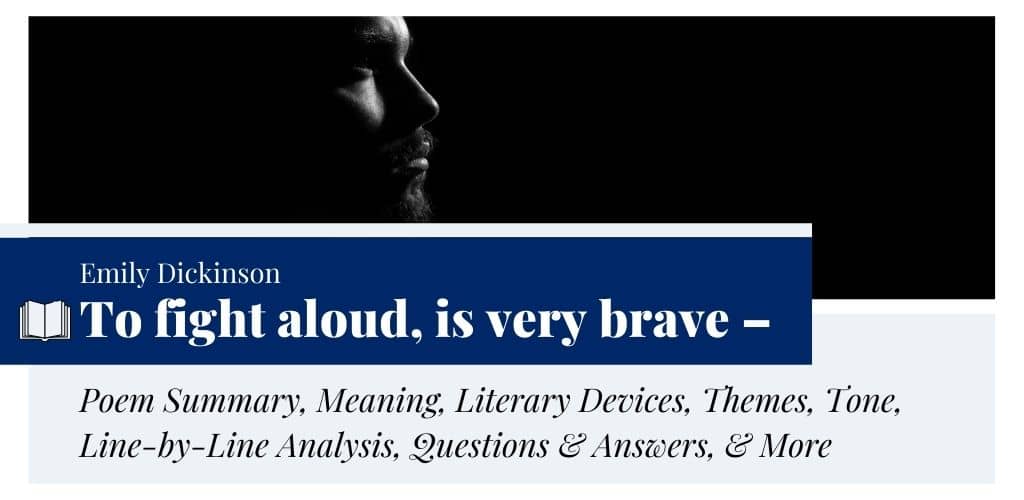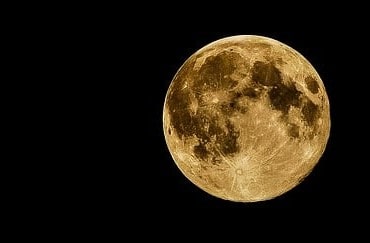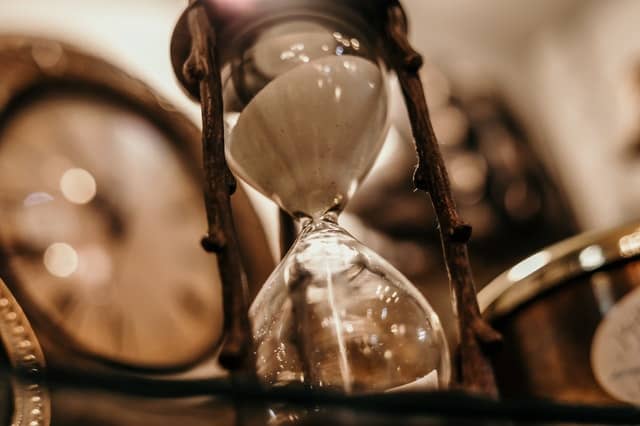To fight aloud, is very brave – by Emily Dickinson
“To fight aloud, is very brave –” is a poem written by one of the greatest 19th-century American poets, Emily Dickinson. This poem was first published as number XVI in Book I of the 1890 collection called Poems, edited by Todd and Higginson; and later as number 126 in the 1955 collection, The Complete Poems of Emily Dickinson by Thomas H. Johnson.
The poem deals with the dichotomy of the internal versus external battles that individuals have to fight in their lives. Dickinson points out how the “internal” or personal struggles of people are often sidelined as physical wars fought on the battlefield. The latter is more visible and glorified. Dickinson champions the cause of the inner fight of “the self,” which she believes is much more difficult as opposed to battles that occupy center stage in society.
- Read the full text of “To fight aloud, is very brave –” below:
To fight aloud, is very brave – (126) by Emily Dickinson To fight aloud, is very brave – But gallanter, I know Who charge within the bosom The Cavalry of Woe – Who win, and nations do not see – Who fall – and none observe – Whose dying eyes, no Country Regards with patriot love – We trust, in plumed procession For such, the Angels go – Rang after Rank, with even feet – And Uniforms of Snow. - from The Complete Poems of Emily Dickinson (1955)

Summary
“To fight aloud, is very brave –” is a poem that looks at personal wars that are just as important and unfathomable as wars fought for the nation by soldiers. As it becomes clear from the title of the poem, Dickinson ardently acknowledges that people fighting aloud in public spheres are regarded as very courageous. However, she says that silent demons in one’s mind are much harder to fight; it is “gallanter” to combat the sufferings (Woe) of the heart and mind. It is unimaginable to face the “Cavalry of Woe,” which is the emotional and mental troubles that individuals face.
She goes on to articulate how unsung warriors who fight inward struggles every day are never applauded or praised as soldiers fighting for the nation are. While these individuals never obtain the “patriot love” from their fellow humans: they are not acknowledged as symbols of national glory, they continue charging through life silently, without public fame.
Dickinson concludes by saying how these peaceful angels are just as resilient as national heroes. They, clad in “Uniforms of Snow,” march silently “with even feet” and make as much impact.
Meaning
In this poem, Dickinson looks inward at the oft-ignored personal struggles that are never a part of mainstream discourse. She focuses on the mental turmoil and inner demons faced by people. Individuals often have to deal with mental and emotional issues silently, as it is considered morally odd and shunned in society. While people laud and glorify soldiers who sacrifice themselves for their country, they never extend the same praise for individuals who overcome grave inner conflicts silently at a personal level. It is easy to sideline the efforts taken individually out of public purview, but it is “gallanter” and commendable to fight alone, without expectation of recognition. Thus, through her poem, Dickinson offers praise and attention to individuals whose efforts are not treated on an equal footing with heroes of national importance, whom the whole world publicly acclaims and showers with “patriot love.”
Form, Rhyme Scheme, & Meter
Form
“To fight aloud, is very brave –” is a short lyric poem, written in the first-person point of view. The poem reflects the speaker’s perceptions of people who combat personal struggles silently as opposed to people like soldiers who achieve public renown. It does not address any particular individual; rather, it is an outward expression of the speaker’s personal opinions and thoughts.
The poem contains three quatrains written using a set rhyme scheme and meter. Dickinson gives the poem a rhythmic, musical quality that becomes evident when it is recited out loud.
Rhyme Scheme
While the poem follows a somewhat consistent rhyme pattern, Dickinson does deviate from it in stanza two. In the first and third stanzas, the rhyme scheme is consistent with ABCB. However, in stanza two, the rhyme scheme is ABAB.
In stanza two, the last word of the first line, “see,” is rhymed with “Country” in the third line. This is an instance of slant rhyme or half-rhyme characteristic of Dickinson’s poetry. The presence of rhyming between the rest of the lines (“observe” and “love”) is what makes the rhyme scheme of this stanza differ from the other two.
Meter
The poem is written entirely in the iambic trimeter (unstressed-stressed foot pattern). However, the number of syllables and length of the lines keep fluctuating throughout the poem in each successive stanza. Most of the lines contain either 4 iambs (iambic tetrameter), such as “Who win,/ and na/-tions do/ not see –” or 3 iambs (iambic trimeter), such as “The Ca/-val-ry/ of Woe –”.
However, Dickinson uses an occasional line with 7 syllables in all three stanzas, which makes the last foot imperfect in these lines. For example, “Who charge/ wi-thin/ the bo/-som.” The poet might have used elision in these lines to fit the meter; for instance, the last vowel in “bos(o)m” can be dropped.
She does this to break the conventional flow and emphasize what is being said through a sudden, unexpected shift in the sound scheme between the lines. In the first two stanzas, this becomes the third line, but in the last stanza, she begins with a 7-syllable line containing an incomplete metrical foot, also called a hypermetrical foot.
The scansion for the poem is as follows:
To fight/ a-loud,/ is ve/-ry brave –
But gal/-lan–ter,/ I know
Who charge/ wi-thin/ the bos(o)m
The Ca/-val-ry/ of Woe –
Who win,/ and na/-tions do/ not see –
Who fall/ – and none/ ob-serve –
Whose dy/-ing eyes,/ no Coun/-try
Re-gards/ with pat/-riot love –
We trust,/ in plumed/ pro-cess(io)n
For such,/ the An/-gels go –
Rang af/-ter Rank,/ with e/-ven feet –
And U/-ni-forms/ of Snow.
Literary Devices
Dickinson makes use of the following literary devices in her poem “To fight aloud, is very brave –”.
- Personification: It occurs in “The Cavalry of Woe.” Here, “Woe” is personified. In the line, “Whose dying eyes, no Country,” “eyes” are given the human quality of dying. It is actually a use of synecdoche using which the poet refers to a dying human being as a whole.
- Anaphora: This can be seen in the following lines, “Who win, and nations do not see –/ Who fall – and none observe –”. The repetition of “who” at the beginning of successive lines is meant for the sake of emphasis.
- Metaphor: In “The Cavalry of Woe,” Dickinson compares “Woe” to the one leading its invisible, “Cavalry” of akin emotions. People who fight personal battles and suffer silently are compared to peaceful angels in the lines, “For such, the Angels go –/ Rang after Rank, with even feet –/ And Uniforms of Snow.”
- Alliteration: The repetition of similar sounds in close proximity can be seen in instances like “brave –/ But” and “plumed procession.”
- Consonance: The sound of the letter “n” is repeated in the lines, “Who win, and nations do not see –/ Who fall – and none observe –” and there is a recurrence of the “r” sound in “Rang after Rank.”
- Enjambment: It occurs in “But gallanter, I know/ Who charge within the bosom/ The Cavalry of Woe –” and “Whose dying eyes, no Country/ Regards with patriot love –”.
Line-by-Line Analysis and Explanation
Lines 1-4
To fight aloud, is very brave –
But gallanter, I know
Who charge within the bosom
The Cavalry of Woe –
In the first quatrain of the poem, Dickinson introduces the principal theme that is people who deal with “woes” of the heart and mind are stronger and more courageous as cavalry who take down enemies. The first line, which is also the title of the poem, makes the speaker’s stance clear – she does acknowledge the tenacity that brave heroes who fight in the physical world demonstrate. However, she takes the side of those whose struggles are hidden, and so is their recognition.
“Calvalry” here refers to the soldiers who fought on horseback. She talks about the “Cavalry of Woe,” which is to say that demons of the mind are no less than a war to be fought with oneself. The inner battles are, in fact, more grave, and the world must acknowledge how difficult it is to fight alone without mental support.
Lines 5-8
Who win, and nations do not see –
Who fall – and none observe –
Whose dying eyes, no Country
Regards with patriot love –
In the next quatrain, the speaker contrasts the fame that soldiers achieve to the absence of fame that is the reality of silent heroes. People who go on struggling and battling with inner conflicts neither obtain their nation’s love or support nor is their fight even recognized by those around them. Soldiers may be rewarded with accolades, public praise, and even be labeled as “nation’s heroes,” but such acclaim never befalls warriors who win over mental sufferings. These individuals suffer and battle the toughest possible horrors every day, but the hypocritical society does not regard their efforts to be important or even worthy of public mention.
The fact that Dickinson capitalizes the word “Country” becomes important; it possibly refers to the national pride or glory that soldiers and national heroes are believed to embody. People whose conflicts go unnoticed also experience pain. Sometimes, their death becomes inevitable as they do not find external support. This is brought out through the line, “Whose dying eyes, no Country/ Regards with patriot love –”.
External love and support go a long way in helping individuals go through the most unfathomable toils of life. But when people have to suffer alone, their struggles are ostracized and neglected, though they deal with twice the amount of pain. Dickinson says that these people never experience the same treatment as soldiers and often have to fight a lonely battle regardless of “patriot love.”
Lines 9-12
We trust, in plumed procession
For such, the Angels go –
Rang after Rank, with even feet –
And Uniforms of Snow.
In the last quatrain, Dickinson continues with the idea that individual battles should be given greater respect. She draws a metaphor here, comparing people who fight inner torments to “Angels,” who are peaceful and silent. This metaphor brings forth a calming image, which is the very nature of individuals the poet is speaking of. Angels are known to be silently miraculous, and they work without expecting fame or recognition in return. Dickinson points out how the heroes she speaks of in her poem are the same; they toil and strive in life and never get approbation or credit.
She also continues the military metaphor seen in the previous stanzas, which can be seen in the line “And Uniforms of Snow.” Angels are always shown to be dressed in white in the religious or Biblical sense, and she contrasts these “Uniforms” with the uniforms that soldiers wear in combat. Even though “Angels” who fight silently do not have outward markers like rank-and-file officers with uniforms and badges, their battles are just as meaningful.
The idea of “angels walking through the snow” further exemplifies the silent nature of personal struggles; walking through the “Snow” with “even feet” does not make noise. The speaker says that personal wars may not be noisy or attention-seeking, but they are more glorious than battles that are fought on the actual field.
Dickinson also seems to be condemning the idea of physical war, which thrives on violence, bloodshed, and loss of innocent lives. This can be seen as one of the interpretations of the poem. She seems to say, individuals who deal with more significant personal hardships should be considered as “heroes,” “patriots,” and inspirational figures; rather than celebrating battles that cause trauma, loss of human lives, and mindless violence. People’s praise is restricted to this idea of toxic, bloody war, rather than supporting and uplifting other human beings in “Woe.”
Themes
The Internal (Invisible) versus the External (Visible) Battle
The idea of the internal in contrast to the external struggle becomes central to the poem “To fight aloud, is very brave –”. Dickinson expands on this theme throughout while championing the individuals who have to struggle with internal, mental struggles away from the public eyes. The view that internal battles are just as difficult to face as battles involving physical scars and bloodshed shines through the entire poem.
Soldiers who give up their lives for the nation garner love and adoration from everyone. However, Dickinson points out how heroes who fight personal wars also embody the virtues of victory and sacrifice. They win individual victories and also fall and die due to the hardships they go through. Just because they fight their battles silently and inwardly, the world does not consider them to be as inspiring. People do not give them the support they duly deserve.
Solitude and Isolation
“To fight aloud, is very brave –” can be seen as mirroring Dickinson’s own personal life, as she led an existence of solitude and did not enjoy being a part of the external world. She always favored the ideas of individual life, isolation, and obscurity as opposed to being in the public sphere and garnering fame. Therefore, this idea is very close to Dickinson’s life, and so the poetic persona can be seen as a reflection of her own thoughts and worldviews. She seems to be speaking her case in the poem by exemplifying the ideas of a meaningful secluded existence.
Unsung Warriors
The actions of individuals who are a part of a larger world may be applauded often. Still, individuals who achieve and exist on a more reclusive scale are just as worthy of respect and recognition. It appears that Dickinson is also reaching out to people who are like herself, who do not come into the public view and yet keep on working and struggling by themselves. She reminds such people that their lives and battles are just as valid and worthy, even if society does not deem them to be as significant as the heroes of the battlefield.
Tone
In “To fight aloud, is very brave –” Dickinson takes on a tone that is hopeful yet poignant at the same time. The binaries in the poem are explored through the binaries in tone. While she expresses regret that individual struggles are never acknowledged and evokes a keen sense of empathy for such heroes whose efforts go unnoticed, at the same time, she also brings out a feeling of inspiration towards such individuals. She gives them hope by recognizing their difficulties and silent sufferings.
There is also a tone of sarcasm that Dickinson uses when she contrasts the importance given to soldiers or public heroes vs. people who fight alone. She uses a lot of military metaphors to talk of internal battles in order to put both kinds of struggles on an equal level and to further throw light on such individuals who epitomize victory over inner conflicts.
Historical Context
Emily Dickinson is one of the most influential American poets of all time. The ideas she speaks about in her poem “To fight aloud, is very brave –” are a reflection of her own life. She lived a life of obscurity and mystery, away from the external world. She had a small group of close friends but never ventured to make herself known to the public. She valued privacy and solitude, ideas that she explicates in this poem.
The fact that only 10 of around 1800 of her poems were published during her lifetime is a marker of how distanced she was from the world of fame and worldly recognition. Through the poem, she seems to be favoring such a life while also articulating the struggles that loneliness and isolation bring, which are just as grave as public struggles. She seems to be saying that one need not always live a publicly renowned existence in order to be meaningful. One can work silently and create just as much impact as Dickinson herself did.
It is also important to note that Dickinson lived through the American Civil War (1861-1865) but did not write a lot of war poetry, which a lot of poets during her time did. This poem, which was written in 1859, is one of the rare instances where she uses war references. The fact that this poem contains a number of military metaphors suggests that she is possibly referring to the Civil War and soldiers who fought in it. She equates them to individuals who fight on a more personal level.
Questions and Answers
Emily Dickinson’s poem “To fight aloud, is very brave –” is about the individual struggles and hardships that people often have to deal with that are not considered significant as compared to external battles such as those fought by soldiers on the enemy line. Dickinson champions the cause of the former, recognizing and praising the deep inner toils that people face alone.
The title builds up a contrast to the central theme expressed in the poem. Dickinson does this as a deliberate measure to further illustrate the paradoxes of internal and external struggles. The title signifies Dickinson’s acknowledgment of the resilience and courage of individuals who fight “aloud,” or in public view, for national or political importance. However, she immediately goes on to subvert this idea in the next line through the word “but,” and from here on, focuses on the people who fight their own battles or mental sufferings. She articulates how they are braver and “gallanter” than the soldiers fighting and dying for the nation.
The central themes of the poem are internal vs. external battles, obscurity vs. public recognition, and seclusion. Dickinson, by building up a contrast of the inner and the outward battles, talks about the absence of public respect that is the reality of those who “charge” against mental distress and suffering out of the public sphere. People who fight alone, without recognition and support, are just as significant as soldiers who exist in a constant spotlight.
According to Thomas H. Johnson, Emily Dickinson wrote the poem “To fight aloud, is very brave –” in 1859. It was first published in the first collection of Dickinson’s poetry entitled Poems (1890).
Those who fight inward battle against their mind, according to Dickinson, charge the “Cavalry of Woe.” They fight their inner demons with will, patience, and self-knowledge, three of their frontline warriors.
The term “plumed” means decorated with feathers, and “procession” means the action of marching forward. Here, “plum” stands for angels, and their march towards the “Cavalry of Woe” is described as “plumed procession.”
The phrase contains a military metaphor. Dickinson compares the abstract idea “Woe” to the leader of its “Cavalry,” referring to emotions related to sorrow. Those who fight inwardly charge the cavalrymen of woe with courage, patience, and determination.
Dickinson uses the term “gallanter” in an unusual fashion. She not only coined the comparative form of the term “gallant” but also italicized the word for the sake of emphasis. In the text, “gallanter” means one who is grander or more impressive.
Some important poetic devices used in the poem are personification, repetition, anaphora, metaphor, alliteration, and consonance.
Similar Poems
- “The Writer” by Richard Wilbur — This poem showcases the inner battle of a budding writer, who, in the poem, is none other than the poet’s daughter.
- “It Couldn’t Be Done” by Edgar Guest — In this poem, Guest’s speaker teaches the art of fighting through obstacles irrespective of what others are saying.
- “On Another’s Sorrow” by William Blake — This poem of Blake is about divine compassion and empathy.
- “Fear” by Khalil Gibran — This piece describes how to win the battle against fear, self-doubt, and lack of confidence.
External Resources
- “To fight aloud, is very brave –”, edited by R. W. Franklin — Read this slightly different version of the text (numbered 138) with alternate wordings to those chosen by T. H. Johnson, published in The Poems of Emily Dickinson (1998).
- The Civil War & Dickinson — Learn about the most artistically productive years of Dickinson’s life and the impact of the Civil War on her writing.
- About Emily Dickinson — Learn about the poet’s life and writing.
- Poet Profile of Emily Dickinson — Check out the poet’s profile and some of her best-known poems.






